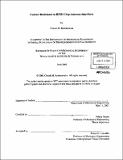Contact resistance in RFID chip-antenna interfaces
Author(s)
Reshamwala, Chetak M. (Chetak Mahesh), 1979-
DownloadFull printable version (1.214Mb)
Alternative title
Contact resistance in radio frequency identification systems chip-antenna interfaces
Other Contributors
Massachusetts Institute of Technology. Dept. of Mechanical Engineering.
Advisor
Sanjay Sarma.
Terms of use
Metadata
Show full item recordAbstract
The purpose of this study was to determine a force-deflection relationship and a force-contact area relationship between a flat planar solid and a spherical solid in terms of material and surface properties of the two bodies. This relationship was determined and it was discovered that the force was directly proportional to both the deflection and contact area. This information is useful in the design and performance of RFID chips. The RFID chip-antenna interface is the area of greatest power loss in the system, and by determining a relationship to increase the contact area in that region, the power loss to the antenna can be reduced. Moreover, an analysis including asperities on the micro scale geometry of the solids was conducted. In the final approach to the problem, a random distribution of asperity types was analyzed. An expression was derived for the total force applied in terms of a given deflection and a range of asperity radii of curvature. A three-dimensional graph was created to show how each of these variables depends on the each other when asperities exist. This relationship is very significant, because it can be used to improve current RFID chip technology to achieve better performance. This expression can also be used to determine specifications in the manufacturing process to achieve a certain deflection or area of contact between the contacting bodies, thereby improving the current manufacturing process.
Description
Thesis (S.B.)--Massachusetts Institute of Technology, Dept. of Mechanical Engineering, 2001. Includes bibliographical references (p. 21).
Date issued
2001Department
Massachusetts Institute of Technology. Department of Mechanical EngineeringPublisher
Massachusetts Institute of Technology
Keywords
Mechanical Engineering.